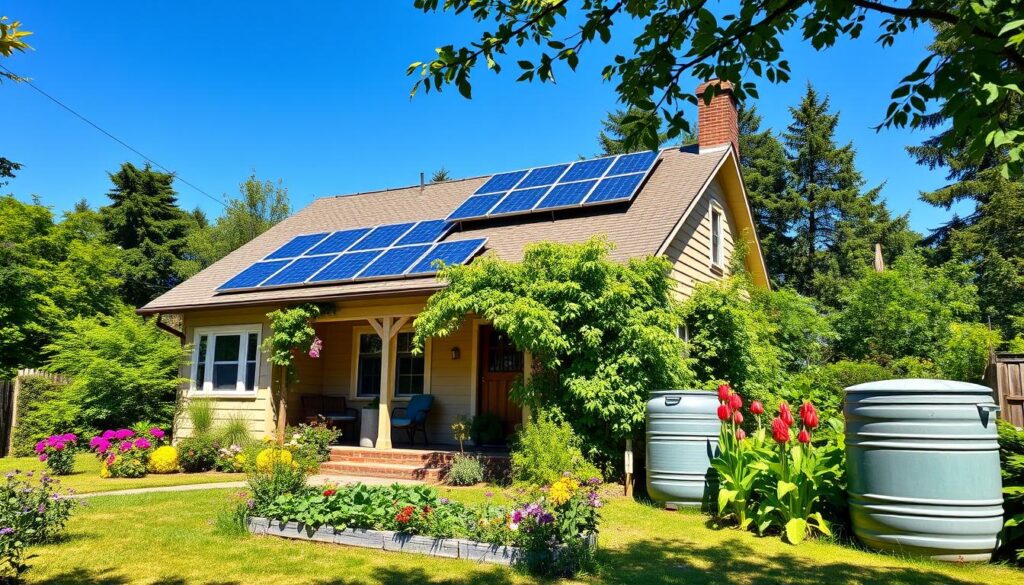Physical Address
304 North Cardinal St.
Dorchester Center, MA 02124
Physical Address
304 North Cardinal St.
Dorchester Center, MA 02124

Climate change is a big issue now, and we all need to act. It’s easy to feel overwhelmed, but we can all make a difference. This article will show you simple ways to live more sustainably and cut down on carbon emissions.

The average American’s carbon footprint is huge, at 18.3 tons a year. This is way above what’s safe for our planet. But, by changing a few things in our daily lives, we can help. We’ll look at ways to use less energy and travel more sustainably. This guide will help you live greener and inspire others to do the same.
Calculating your carbon footprint is the first step to reduce your environmental impact. Your carbon footprint is the amount of greenhouse gases you produce. This includes carbon dioxide, methane, nitrous oxide, and fluorinated gases. By knowing your current carbon impact, you can find ways to lower your emissions.
The average person in the U.S. has a carbon footprint of 16 tons of CO₂. This is much higher than the global average of 4 tons. To meet the Paris Agreement’s goal, we need to lower our carbon footprint to below 2 tons by 2050.
| Sector | Contribution to Emissions |
|---|---|
| Buildings | Around 33% of New York State’s greenhouse gas emissions |
| Transportation | Approximately 28% of statewide greenhouse gas emissions in New York in 2019 |
| Food and Waste | Significant contributor to global emissions, with food waste alone accounting for 1.3 billion tonnes annually |
Online carbon footprint calculators can help you estimate your emissions. They consider your energy use, transportation, and consumption habits. This information helps you focus on areas to improve and plan to reduce your Carbon Footprint Calculation and Greenhouse Gas Emissions.
Starting to fight climate change is easy. Just make small changes in your daily life. These changes can greatly reduce your carbon footprint and help our planet. Here are some simple steps to begin:
First, think about what you eat. Choose foods that are lower on the food chain. Opt for organic and local produce, and buy in bulk. Also, don’t waste food and compost your leftovers. This can really cut down on landfill emissions.
Small changes in energy use can make a big difference. Wash clothes in cold water and use energy-saving appliances. Turn off lights and unplug devices when not in use. Setting your thermostat to 78°F in summer and 67°F in winter also saves energy.
| Energy-Saving Tip | Estimated Energy Savings |
|---|---|
| LED light bulbs | 75% energy savings compared to incandescent bulbs |
| Washing clothes in cold water | 25-40% energy savings compared to hot water |
| Programmable thermostat | 10-30% energy savings on heating and cooling costs |
By making these simple changes, you can cut down your carbon emissions. This helps with Energy Conservation and Waste Reduction. Every small action counts for the health of our planet.

Our food choices are key to reducing our carbon footprint. The food industry is responsible for over a quarter (26%) of global greenhouse gas emissions. Livestock alone is responsible for nearly 15% of all human-made greenhouse gas emissions. By choosing eco-friendly foods, we can greatly reduce our environmental impact.
Start by eating less meat and dairy. Opt for organic and locally-sourced foods to cut down on transportation emissions. Plan meals with seasonal produce to reduce emissions further. Freeze leftovers and reuse food to fight food waste, a major greenhouse gas emitter.
Supporting urban agriculture, like Lufa Farms, shows how we can lower costs and emissions. Organic farming protects biodiversity by supporting beneficial insects like bees. Sustainable food choices not only reduce our Eco-friendly Eating impact but also support local Local Food economies and promote healthier eating.
| Food Item | Carbon Footprint (kg CO2e per kg) |
|---|---|
| Lamb | 39.2 |
| Beef | 27.0 |
| Cheese | 13.5 |
| Pork | 12.1 |
| Organic Produce | 2.0 |
| Poultry | 6.9 |
| Beans | 2.0 |
| Lentils | 0.9 |
By choosing Eco-friendly Eating options, we can significantly lower our carbon footprint. Whether it’s choosing Local Food or Organic Produce, every choice we make counts towards a greener future.
Start reducing your carbon footprint at home with energy-efficient upgrades. An energy audit can show you where your home is wasting energy. Switch to LED lighting, which uses 75% less energy and lasts 25 times longer than old bulbs.
When buying new appliances and electronics, look for the ENERGY STAR label. These products use less electricity and water, saving you money and the planet. Think about getting a tankless water heater, which only heats water when you need it.
Making small changes can make a big difference. Lowering your water heater to 120°F can save 550 pounds of CO2 each year. Using low-flow showerheads can save another 350 pounds of CO2 annually. These changes can greatly reduce your home’s carbon footprint and help the environment.
| Energy-Efficient Upgrade | Annual Carbon Savings |
|---|---|
| Upgrade to LED Lighting | 550 lbs CO2 |
| Lower Water Heater Temperature to 120°F | 550 lbs CO2 |
| Install Low-Flow Showerheads | 350 lbs CO2 |

Transportation is a big source of carbon emissions in the U.S. But, there are smart ways to cut down on this. Try walking, biking, or using Public Transit when you can. These choices are better for the planet and keep you healthy and active.
If you must drive, drive smart. Avoid hard braking and speeding up. Or, think about getting an Electric Vehicle. They’re much cleaner than gas cars and are good for the planet.
For air travel, pick nonstop flights and economy seats. They’re better for the environment. First-class seats can emit a lot more CO2. Also, flying straight to your destination cuts down on emissions, especially from takeoff and landing.
By choosing wisely, you can greatly reduce your carbon footprint. Go for Green Transportation, think about Electric Vehicles, and use Public Transit when you can. This helps make our world cleaner and healthier.
To lower our carbon footprint, we must shop sustainably and reduce waste. Choose quality, long-lasting clothes over fast fashion. Opt for vintage or recycled items and use reusable bags to cut down on packaging.
Support companies that care about the environment. This helps them grow and encourages others to do the same.
Every year, the average American throws away about 80 pounds of clothes. Most of it ends up in landfills. By choosing wisely and reducing waste, we can make a big difference. Donate or sell clothes you no longer wear, recycle, and repurpose whenever you can.
Unsubscribe from brand emails and unfollow fast fashion brands. This helps stop the endless cycle of buying pushed by ads.
Buying second-hand clothes helps clothes last longer and cuts down on waste. Try to buy local to reduce carbon emissions from shipping. Ask brands about their production and materials to demand better. Supporting local designers who don’t outsource can also help.
| Impact | Statistic |
|---|---|
| Returned Online Orders | 30-40% of all online orders are returned, with 20% of those returns ending up in landfill due to being unsellable by the retailer. |
| Plastic Bag Consumption Reduction | The 5p charge in the UK helped reduce plastic bag consumption by up to 90%. |
| Localized Production | Localizing the production process significantly reduces the carbon emissions from transporting goods globally. |
By choosing Eco-friendly Products, Recycling, and Upcycling, we can all help create a greener future. Together, we can reduce waste, support fair fashion, and lower our carbon footprint.
Weatherizing your home is a simple yet effective way to reduce your carbon footprint. By adding insulation, sealing air leaks, and upgrading your windows and doors, you can cut your HVAC energy use by up to 40%. These home insulation and energy-efficient window upgrades not only lower your energy bills but also improve indoor air quality and comfort.
Properly maintaining your HVAC system is another key step. Keeping air filters clean and ensuring your system is running efficiently can significantly optimize HVAC energy consumption. Consider installing a programmable or smart thermostat to automate heating and cooling, further enhancing energy efficiency.
When possible, use fans instead of air conditioning to stay cool. This simple swap can make a meaningful difference in your home’s energy usage and carbon emissions. By embracing these weatherization and climate control strategies, you can lower your environmental impact while enjoying a more comfortable living space.
| Home Insulation | Energy-Efficient Windows | HVAC Optimization |
|---|---|---|
| Reduces HVAC energy use by up to 40% | Enhances indoor comfort and air quality | Keeps systems running efficiently |
| Improves home comfort and air quality | Lowers energy bills and carbon footprint | Enables smart thermostat programming |
By implementing these simple home weatherization and climate control strategies, you can make a meaningful impact on reducing your carbon footprint and enjoying a more energy-efficient, comfortable living space.
As homeowners, we can make a big difference by using clean energy. Switching to solar panels or joining wind power projects is a great start. In 2021, renewable energy made up about 12.4% of U.S. energy use. This shows we’re moving towards cleaner energy.
Consider using ground source or air source heat pumps for your home’s heating and cooling. These options can cut down your carbon footprint and save money in the long run. Even trees can help save up to 30% of energy in a home if placed right.
New York is leading the way in community-based renewable energy. By 2023, it had two gigawatts of renewable energy through its community solar program. Joining these local efforts can help us move towards a greener future.
Our efforts to cut down on carbon can really make a difference. But when we join forces, we can do even more. Advocacy and community engagement are key to tackling climate change.
Start by joining local environmental initiatives. Help out at clean-up events, plant trees, or support sustainability programs. Your time and voice can make a big difference. Also, stay updated on climate policy and vote for leaders who care about the planet.
Teaching others about sustainability can spark action. Host workshops, start discussions, or join forums. This way, we can all work together and make a bigger impact.
Remember, community action is about more than just personal change. It’s about working together to solve big environmental problems. Together, we can create a better future for everyone.
Carbon offsetting is a key strategy in the battle against climate change. It involves funding projects that cut down greenhouse gas emissions. This way, you can balance out your own carbon footprint.
For instance, offsetting a flight from New York to Los Angeles, which emits about 1.5 tons of CO2, can cost just $43. Companies like Myclimate, Cotap, and Terrapass support projects globally. These range from renewable energy to forest conservation.
Carbon offsetting is not a replacement for reducing your emissions directly. Yet, it’s a crucial part of your sustainability plan. By backing projects that reduce or remove greenhouse gases, you help offset your daily emissions. This way, you contribute to global Sustainable Development.
The world aims to reach net-zero emissions by 2050. Carbon Offsets and Emissions Compensation are key to this goal. By taking charge of your carbon footprint and supporting verified projects, you can significantly impact the fight against climate change.
It’s important to check your carbon footprint often. This helps you see how far you’ve come and what you can do better. Set clear goals for cutting down emissions and keep up with new ways to reduce your footprint.
Sharing your wins and struggles with others can really help. It motivates you to keep working towards a greener lifestyle.
Keeping an eye on your Carbon Footprint Monitoring and reviewing your Sustainability Goals often is key. Always be ready to change your Lifestyle Changes when you learn something new. This way, you can really make a difference for the environment.
The path to a lower carbon footprint is a long one. But by checking your progress, staying updated, and working together, you can create real change. And that’s good for our planet.